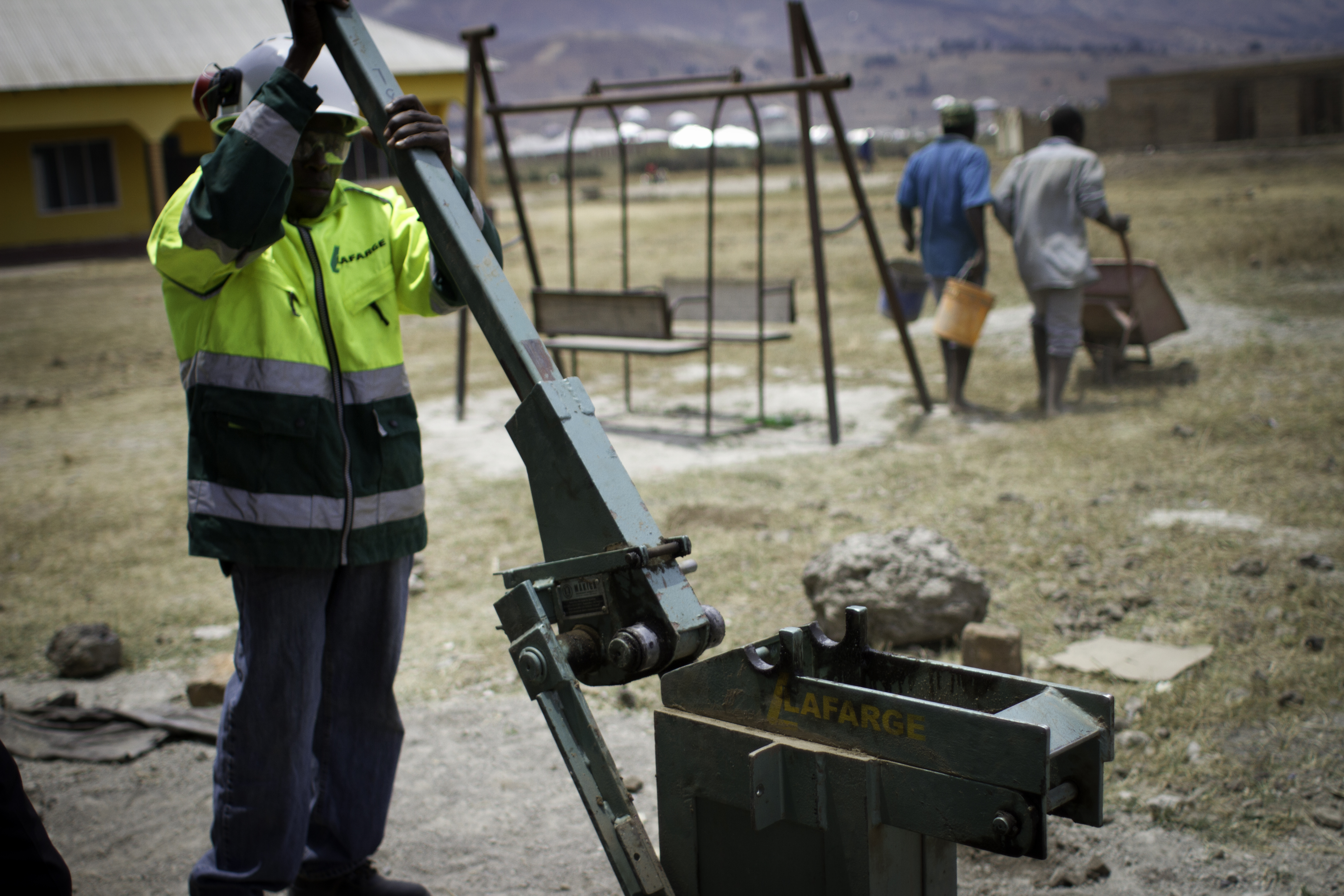
Across the world, people are chopping down trees to burn bricks to build their homes. The world’s largest cement manufacturer thinks there’s a better way
On a sunny hill overlooking a valley of shrubs, yellow grass and maize, Deodat Madembwe watches a team of masons make bricks for an elementary school he’s building.
As a young man growing up in central Tanzania, Madembwe too was a mason. Back then the most popular way to make bricks was to mold them loosely out of dirt and clay and then burn them in a tanuru—the Swahili word for a kiln. But to heat the kiln was to wreak havoc on the local environment.
“People cut trees to burn bricks,” he explained. To burn enough bricks for about five houses, they’d have to fell 10, even 20 trees. Burning the trees releases CO², contributing to climate change, and deforestation means there are fewer trees left to combat it. As Tanzania’s population grew, more and more houses arose and the landscape suffered. “We [were] making a desert,” said Madembwe.
But today, on a sunny plateau above Mbeya, the masonry unfolding before Madembwe’s eyes is of an entirely different breed. Two men with shovels quickly mix dirt they’ve sifted with a bit of sand and cement. They add water and shovel the mixture into a small steel device. A third man closes the heavy metal lid and pulls down hard on a long green lever. He releases, and a perfectly rectangular gray brick rises up.
NGOs, governments and local cooperatives have been experimenting with so-called compressed stabilized earth blocks (CSEB), a green alternative to tree-consuming burnt bricks, on a small scale for years. But they may soon rise to global prominence, prompted in part by interest from an unlikely party: the largest cement manufacturer in the world.
The French-Swiss company LafargeHolcim is betting on a product it calls the DuraBric as part of its global push to expand affordable housing. Since 2013 they’ve distributed nearly a dozen hand-operated brick presses around the dusty town of Mbeya, Tanzania, as well as in Rwanda, Cameroon and Zambia. The devices cost about US$2,000 each to manufacture, but the company lends them out for free on the condition that users fill them with LafargeHolcim brand cement.
The process that led to the creation of the Durabric started with an experiment that didn’t work as planned, explained François Perrot, who heads the company’s global affordable housing program. A few years back the company introduced a low-cost plaster product in India designed to hold mud houses together. But it didn’t sell—people preferred to build new houses with bricks rather than protect their old ones with plaster. Noting this preference, researchers at LafargeHolcim’s R&D lab in Lyon, France, began testing ways to mix cement and dirt for bricks.
Around this time, a continent away, a delegation of government officials in Malawi approached LafargeHolcim looking for a greener alternative to the burnt bricks that were contributing to their country’s deforestation. Suddenly LafargeHolcim had a market for its earth-cement recipe. It quickly furnished a prototype of the brick press and used it to build an NGO-funded school in Malawi’s capital.
When done right, earth bricks are stronger and more weather-resistant than burnt clay ones. Studies have shown that using soil-stabilized bricks to build a home or school can save 20 to 30 percent on the project’s overall cost. What’s more, because the bricks are perfectly uniform, homebuilders need to use far less mortar to fill the cracks, and often decide not to plaster the outside of the house. This reduces the amount of cement, the manufacture of which is responsible for around 5 percent of global C0² emissions.
LafargeHolcim is developing a press to make interlocking bricks, which require less mortar still.
Citing research by a brickmaking NGO in India, the company claims that DuraBric blocks release 13 times less CO² than burnt bricks. And it estimates that CSEB emit 20-25 percent the CO² of concrete blocks. “It’s a combination between affordable and sustainable,” said Perrot. The cost reduction is a draw for local builders, and he said the environmental benefits are attractive to NGOs. Meanwhile Perrot’s team is working to persuade local government officials to promote the use of DuraBric blocks in public construction projects.
Still, there are challenges. Masons who have spent their entire lives building homes the burnt-brick way must be persuaded and trained to use the machine, and with careful attention to detail: an incorrect ratio of soil to sand to cement can weaken the brick. As we visited DuraBric sites around Mbeya, we encountered piles of bricks left out to dry in the sun that should have been covered by tarps instead—a crucial step that ensures the bricks retain moisture and properly set. Drop one of these sun-dried bricks from waist height and it disintegrates back into dust.
Even well-made bricks won’t last as long if the foundation or the roof is shoddy. “A brick is still 90 percent soil. It can erode. That’s why you need a good roof and an overhang so it doesn’t rain directly on the wall,” said LafargeHolcim project manager Théophile Balay, who visits each of the machines on a weekly basis to nudge masons in the right direction.
The DuraBric is unlikely to sell everywhere. Perrot said that in countries like Morocco people adamantly prefer cement blocks over earthy ones. But elsewhere in Africa, people are recognizing the environmental benefits of the new technique. In fact, the bricks have proven so popular that LafargeHolcim is constructing a factory in Lilongwe, Malawi’s capital city, to manufacture them en masse—as many as 10,000 per day, or enough for two homes.
By Jacob Kushner


























